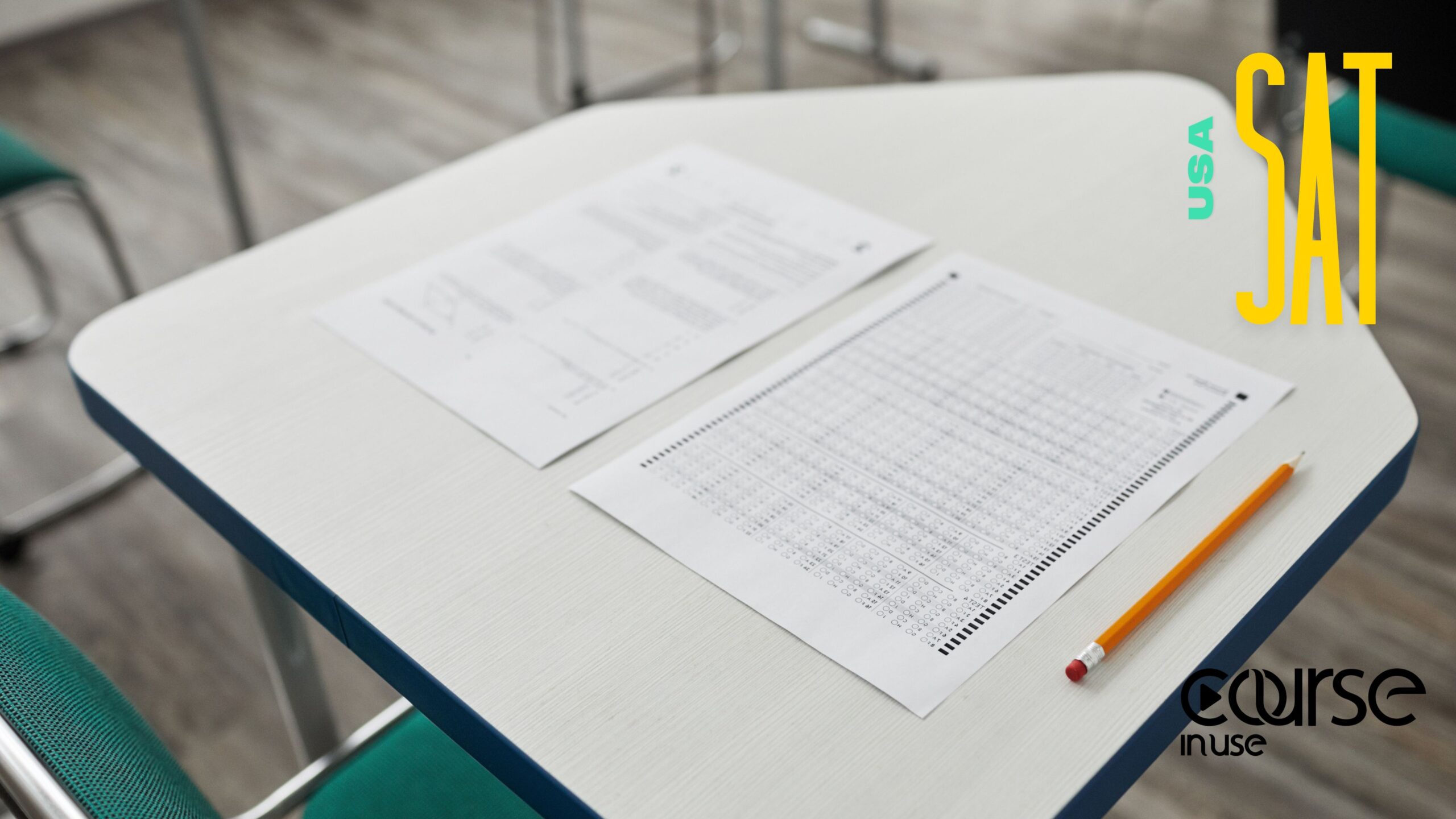The SAT exam (Scholastic Assessment Test) is a standardized test widely used for college admissions in the United States. It is designed to assess a high school student’s readiness for college and provide colleges with a common data point to compare all applicants. Generally, the SAT exam is designed to assess the writing, verbal, and math skills of candidates. Applicants who wish to enroll in undergraduate programs and continue their education at this level, especially in countries such as the United States, Australia, and Canada, are required to take the SAT exam and achieve a passing score.
Structure and Components of the SAT Exam
The SAT exam consists of the following main sections:
- Evidence-Based Reading and Writing (EBRW):
Reading Test:
-
-
- Includes passages from literature, historical documents, social sciences, and natural sciences.
- Questions test comprehension, reasoning, and analysis skills.
-
Writing and Language Test:
-
-
- Includes passages with questions that test grammar, usage, and editing skills.
- Questions also assess understanding of the context and effective language use.
-
- Math:
Math Test – No Calculator:
-
-
- Includes questions on arithmetic, algebra, geometry, and basic trigonometry.
- Focuses on assessing the ability to solve problems without the aid of a calculator.
-
Math Test – Calculator:
-
-
- Includes more complex questions that allow the use of a calculator.
- Covers a broader range of topics including advanced algebra and some trigonometry.
-
- Optional Essay (Discontinued in 2021): Previously included an essay section where students analyzed a given argument.
As of June 2021, the Essay section has been discontinued except in states where it’s required as part of SAT School Day administrations.
SAT exam Scoring system
- Each main section (EBRW and Math) is scored on a scale of 200-800.
- The total score ranges from 400 to 1600.
- Additional sub-scores and cross-test scores are provided for more detailed insights into a student’s performance.
- SAT scores range from 400 to 1600. The highest possible score is 1600, while the lowest is 400. Your total SAT score combines two main sections: Math and Evidence-Based Reading and Writing (EBRW). Each section is scored between 200 and 800 points
Duration
- The exam takes about 3 hours to complete, plus an additional 50 minutes if the Essay section was included (when it was offered).
Purpose of taking SAT test
- The SAT is used by colleges and universities to assess applicants’ academic readiness and is a key component in the college admissions process.
- It is also used for scholarship considerations and placement in college-level courses.
| Section | Subsection |
|
|
|
|||||
|
|
|
|
|
|||||
|
|
|
|
||||||
| Math |
|
|
|
|
|||||
|
|
|
|
||||||
|
|
|
|
Analytical writing, essay
|
Costs of the SAT Exam
The costs associated with the SAT exam vary depending on the type of exam and the location of the test center. Generally, the costs are as follows:
- SAT without Essay:
- Base fee: $60
- SAT with Essay (before its discontinuation in 2021):
- Base fee: $85
Additional Fees
- Change of Test Date or Test Center: $25
- Late Registration: $30
- Waitlist Fee: $53 (if space is available on test day)
- Additional Score Reports: $12 per report
- Score Reporting by Phone: $15 per call
Fee Waivers
- Some students may be eligible for fee waivers, especially those facing economic hardship. These waivers can cover the registration fee, score reports, and some additional fees.
For the most accurate and up-to-date information on fees and waivers, please visit the official College Board website.
SAT Score Range: What is a Good SAT Score for Colleges?
The SAT score range considered good and acceptable varies depending on factors such as the type of college and desired field of study. However, we can provide a general overview of SAT scores:
1. Total Score:
For most colleges, scores above 1200 are considered good and acceptable.
Scores above 1400 are seen as very good and can enhance the likelihood of acceptance into reputable universities.
2.EBRW and Math Scores:
Scores of approximately 600 or higher in each section of Evidence-Based Reading and Writing (EBRW) and Math are generally considered good.
Scores above 700 are considered very good and excellent.
3.Subcores and Cross-Test Analysis:
Subscores such as Command of Evidence in EBRW and Heart of Algebra in Math reflect specific skills that are important in assessing academic and mathematical abilities.
4.Alignment with College Expectations:
Some colleges may have specific criteria for admission that may differ from these ranges. Therefore, applicants need to familiarize themselves with the specific criteria of each college before applying.
For more precise and up-to-date information, you can visit the official College Board website or consult with your school counselors to learn more about SAT scores.
How to send SAT scores to universities?
- Log into Your College Board Account: Visit the College Board website and log in to your account. If you don’t have an account, create one.
- Access Your SAT Scores: Inside your account, find the section labeled “My SAT” or “My Scores” to access your SAT scores.
- Choose the Option to Send Scores: Look for the option to send scores. It may be labeled as “Send Scores” or something similar.
- Select Universities and Institutions: Choose the universities or institutions where you want to send your scores. You might need to enter specific institution codes.
- Confirm and Pay the Fee: Confirm your selections and proceed to pay the score-sending fee. Fees vary based on the number of institutions you select.
- Confirmation and Status: After payment, you’ll receive a confirmation email. You can also check the status of the score sent to your account.
Remember that specific details may vary, so it’s always a good idea to visit the official College Board website or consult with your school counselors for personalized guidance
6 Top tips to succeed in the SAT exam
1. Understanding the structure and timing of the SAT test
If you want to succeed in the SAT test, your first important step is to know the structure of each section and its timing. Refer to the SAT test structure table and remember it. This table will help you manage your time better on the day of the test.
2. Proceed with a coherent and regular study program
The point that is very important in your success in the SAT exam is persistence and study. You need about 100 hours of regular study to prepare for the exam in at least 3 to 6 months.
3.Use of experimental tests
One of the most effective ways to prepare for the SAT exam is to use preparation and simulation tests. Because these tests are similar to the main test, in addition to helping you manage time, they also familiarize you with the structure and manner of the SAT test questions. In other words, you can identify your strengths and weaknesses with the help of tests
4.Focus on your weaknesses
Among the points that you should keep in mind as a candidate for the SAT test is that you should never ignore your weak points and omit a topic, but focusing on the weak points can be very effective in raising your score in the SAT test.
5.Learn time management techniques
As mentioned, the SAT exam has a time limit, in other words, you have to answer the questions of each section in a certain time, but don’t worry, you can strengthen your time management skills by practicing and using online practice tests.
6.Expand your vocabulary and grammar knowledge
As a candidate for the SAT exam, you must have a strong vocabulary and high grammar skills. We suggest that to face this challenge, it is better to read reputable publications such as the New York Times, Atlantic or Scientific American on a daily basis. So that you can acquire the necessary skills to answer the questions in the comprehension section of the SAT test
Course In Use website is the best Comprehensive resources for learning international online courses and preparing for international exams.




